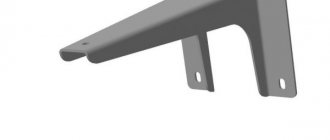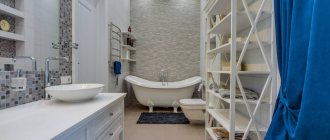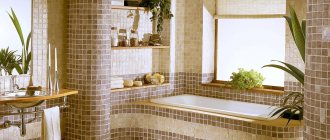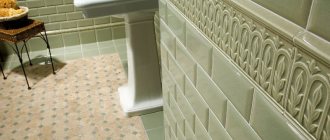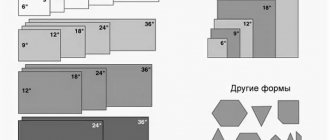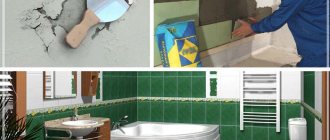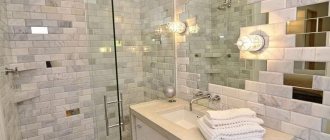Porcelain tiles and tiles, similarities and differences
There is an opinion that porcelain stoneware differs from tiles in the presence of natural stone particles. This is a common misconception. The composition of these finishing materials is identical. It includes:
- purified clay suspension;
- kaolin clay;
- feldspar;
- quartz sand;
- coloring natural pigments.
Porcelain tiles contain particles of natural stone
The differences in the technological characteristics of these materials are ensured by the specifics of the production process. Porcelain stoneware blanks are pressed with increased pressure of about 500 kg/sq.cm and processed at high temperatures of 1300 degrees.
Porcelain tiles are ideal as bathroom tiles, since high pressure and temperature lead to the melting of the clay, forming a monolithic structure. There are no pores in this material, like in tiles, moisture cannot penetrate into it. This prevents destruction of the structure.
Porcelain tiles make it easy to create an attractive design.
Many people are attracted to glazed tiles, which have high aesthetic qualities. But by purchasing porcelain tiles for your bathroom, you can create an equally attractive design. Moreover, the decor of this coating will last longer, since the coloring substances are not in the glaze, but in the composition of the tile.
Porcelain tiles for bathroom floors and walls
Basically, the walls are decorated with polished or glazed porcelain tiles. It perfectly reflects light and expands the space in small rooms.
The well-known postulate that how many people, so many opinions, speaks for itself. There are a huge number of porcelain stoneware manufacturing plants. The quality of the products also varies greatly.
Accordingly, there is no consensus on this or that product either. Some people like to work with Russian materials, such as Italon Charme Extra tiles, some prefer European materials, and others choose Ukrainian ones. Therefore, we will simply consider the products that are most in demand on the Russian market.
Kerama Marazzj
More than 2000 titles have been developed - these are 12 collections of the Russian manufacturer. The only brand in the production of which European DRY PRESS technologies are used. This allows you to accurately style natural stone.
Positive traits:
- Relatively inexpensive cost,
- Good geometry, cuts well,
- Stylish, attractive design solutions,
- Rated as quite durable, resistant to mechanical shock.
Disadvantages: sometimes in collections the combination of colors or shades is poorly selected, there are deviations in length.
Fap Ceramiche
Expensive elite Italian porcelain tiles. It has been produced for many years at a plant in the city of Sassuolo, which naturally speaks of the quality of the material produced.
Designers have created almost 30 collections, the main emphasis being safety and environmental friendliness. The surface pattern is created to resemble natural stone, marble, wood.
Advantages:
- Excellent design solutions,
- Solid choice
- Quality products,
- Resistant to mechanical damage,
- The appearance is very respectable,
- Cuts well.
Among the shortcomings, it can be noted that sometimes the geometry of the elements is “lame”, there are deviations in size. Prices are quite high for the average consumer.
Keramin
Belarusian porcelain stoneware is created at the Minsk brick factory. More than 80 collections were released. Relatively low price, size range from 10x10 to 27.5x40 cm. In general, the quality is in accordance with the cost.
Pros:
- Large thematic selection,
- Interesting design patterns on the surface,
- High quality, durable products,
- Availability of interesting collections,
- Cuts well.
But: sometimes in collections there are discrepancies on the side of the tile of 1-2 mm, deviations in width and length.
Golden Tile
Ukrainian porcelain tiles from the Kharkov plant. The enterprise has organized the Italian bureau SRS, Poligraph, Tecnografica. More than 60 collections have been developed. The plant uses the latest special technologies for digital printing on surfaces.
The cost is low or medium - depends on the selected collection. In one batch there are discrepancies in penumbra or shades. Dimensional discrepancies are common.
Positive traits:
- The quality of porcelain tiles corresponds to the price (local raw materials are used),
- Wide choose,
- Great job from the designers.
Disadvantages: deviations on the side, there is a discrepancy in shades between different batches of the same collection.
Unique properties of porcelain stoneware
The absence of pores, the perfectly smooth surface of the material prevents the penetration of water into the structure. But not only this feature makes it advisable to use porcelain stoneware in the bathroom. Specific technological processing provides it with strength comparable to that of natural granite. These coatings:
- have maximum wear resistance;
- can be cleaned without fear of scratching the surface;
- do not become cracked during operation;
- inert to aggressive chemicals.
Material characteristics guarantee long service life
These technical characteristics guarantee long service life, ease of maintenance, and cleanliness. Photos of porcelain tiles for the bathroom allow you to appreciate the excellent aesthetic characteristics of the material. Its advantages include a large assortment, allowing you to make a good choice for any design.
Temperature changes are not dangerous for coatings; they retain their structure over a wide range. You can use porcelain stoneware for bathrooms, baths, saunas, and outdoor decorations.
Porcelain tiles have maximum wear resistance
Types of coatings
Manufacturers offer consumers a wide range of these finishes, allowing you not to limit yourself in choice. It contains material:
- matte, polished, glazed;
- for covering floors and walls;
- standard and non-slip;
- in classic, modern design;
- plain and printed.
When choosing porcelain tiles for the wall in the bathroom, you can give preference to noble matte coatings, spectacular polished tiles, glazed material with original, multi-colored decor. These types of porcelain stoneware are not used for floor finishing, since the polished coating creates a risk of slipping and injury, and the glaze can wear off under such operating conditions.
Spectacular polished tiles
Special tiles designed for flooring have a non-slip texture. There are several processing technologies. In satin finishing, a pattern is created on blanks of mineral salt and fixed under the influence of high temperatures. Structuring allows you to create accurate imitations of wood, leather, stone, etc. In the photo of porcelain tile designs in the bathroom you can see many such options.
Porcelain tiles imitating wood
The range of this material includes tiles of different sizes. There are elements of medium size, large format, square, and complex configurations. You can purchase porcelain tiles for your bathroom, taking into account the size and layout features.
Types: different for walls and floors
Porcelain tiles for the bathroom are available in such a diverse range that you can choose the most suitable modification depending on the purpose of the coating and personal preferences. Quality and safety standards for this room provide for the use of several types of porcelain stoneware: matte, polished, glazed.
Walls
Porcelain tiles for bathroom walls are most often glazed or polished tiles. The wall layer reflects light to the maximum, providing good illumination of the room and visually expanding it. This is especially valuable for small areas.
As a floor covering, these varieties are not very good, since the glaze can wear off over time, and the polish is too slippery.
Floor
Types with a non-slip coating are practical and safe. Porcelain tiles for bathroom floors are available in three options:
- Satin. Technology gives the material a special shine. A pattern is applied to the raw tile, and after frying, a softly glowing non-slip surface is obtained.
- Structured. Matte surface with convex ornament. This technology produces an imitation of parquet, leather, and other coatings of unusual structure. This bathroom floor is both beautiful and safe.
- Technical. Externally, the tiles resemble natural stone. The cheapest variety, basic for other types, including the newest types of glazed porcelain tiles. It is positioned as something unusual, but in reality it turns out that it is technical porcelain tile covered with smalt glaze. It looks beautiful, is expensive, although in fact it is the same tile.
Porcelain floor tiles of any type have anti-slip properties.
The safest floor tiles are matte or with a rough base. It is ideal because it collects less water and is the most difficult to slip on.
Ceiling
In the bathroom, glossy porcelain tiles are attractive, but they are not suitable for all rooms. If you really want to, it is better to choose a light shade so that the ceiling does not hang over, visually reducing the space.
You should not lay porcelain tiles in a room partially tiled with small-format ceramic tiles: the difference in texture will be obvious. Both tiles and granite will lose from such a neighborhood.
In this segment of building materials, the term “rectified porcelain stoneware” is used. It means the highest level of processing, compliance with all parameters down to the smallest detail and is applicable to any type of material with luxury quality.
The most popular porcelain tile
All types of this material are popular. There is a conditional rating that can help if you want to choose a fashionable, stylish finishing option. When choosing porcelain tiles for the bathroom wall or floor, pay attention to the materials:
- in neutral colors - white, gray, red, black;
- imitating wood, leather, stone;
- with original, unusual decor.
Neutral tones are used in both classic and modern styles. These coatings are ideal for visual correction and become an excellent backdrop for furniture and plumbing equipment. In the photo of porcelain tiles for the bathroom there are many options for combining colors. This technique is used to create unique interiors.
Neutral colors make a great backdrop for furniture
Nowadays, porcelain stoneware is in high demand as bathroom tiles, imitating various natural materials. You can choose the warmth and comfort of wood, the grandeur and elegance of stone, the solidity and chic of leather. These coverings provide an opportunity to give the environment a certain character, make it original and interesting.
Numerous photos of designs of porcelain tiles in the bathroom allow you to correctly select the material for a specific interior, ensure its harmony and compliance with fashion.
The elegance of stone for a modern interior
When purchasing this material, you must ensure the quality of the product. The main guarantor is the popularity of the manufacturer. But no one is immune from fraud. Before purchasing porcelain tiles for your bathroom, you should weigh the packaging. A discrepancy in mass may indicate technology violations. Pay attention to the reverse side. Technological recesses should not be more than 2x2 cm. Make sure that the shade of the batch tiles completely matches.
How to choose porcelain tiles for the bathroom
You can use various finishing materials for the bathroom, but one of the best options is porcelain tiles. It meets all the necessary requirements, is durable, resistant to moisture, and has a stylish, attractive appearance.
Porcelain tiles for the bathroom: general requirements for coating Porcelain tiles are an excellent option for finishing a bathroom. But manufacturers today offer a wide range of materials with different properties, which are not always suitable for bathrooms. Therefore, when choosing, you should pay attention to the presence of the following characteristics:
• anti-slip properties (prevents injuries even when the floor is wet); • resistance to the negative effects of moisture, detergents, and abrasives; • resistance to scratches and shock loads; • maintaining an attractive appearance.
When choosing, it is immediately recommended to exclude corrugated tiles, as they are difficult to clean. The optimal materials are those with a rough, smooth finish (but not polished).
In terms of wear resistance, porcelain tiles marked PEI I, II, III are suitable for bathrooms. This is a material for low and medium traffic intensity, the first two classes are specifically designed for bathrooms.
For the bathroom, you should select a material that will be resistant to abrasives, chemicals, and with good acid resistance. The porosity of porcelain stoneware should be low, and the resistance of the base should be excellent. On the packaging these properties are usually indicated:
• shaded background and foot – high wear resistance; • black background and foot – material for laying on the floor (high strength).
Additionally, markings may be indicated according to the degree of abrasion resistance and the presence of anti-slip properties, which is mandatory for a bathroom.
Types of porcelain tiles When selecting porcelain tiles for the bathroom, great attention should be paid to its type and properties. Today on the market tiles are presented in the following options:
• technical porcelain stoneware (highly resistant to abrasion, looks like natural granite);
• matte tiles (glazed or technical, durable and hard, low cost); • glazed tiles (technical porcelain tiles with a glazed surface, fired at a high temperature, are not very durable, but are suitable for bathrooms); • waxed (satin) porcelain tiles with a soft shine (the surface does not slip, the strength is average); • rectified porcelain tiles are used for seamless flooring that imitates a monolithic coating; • polished porcelain tiles are very durable, not recommended for bathrooms due to the too slippery surface; • semi-polished coating is distinguished by a spectacular alternation of matte and glossy zones; it is not recommended for bathrooms; • structured material imitates the surface of wild stone, brick, and is durable and has anti-slip properties.
Which size should I choose? The next step is to choose the size of porcelain tiles. Today, the market offers rectangular and square-shaped materials with a side length of 20-60 cm. Smaller tiles are used as decoration or an accent; larger sizes are rarely used for the bathroom.
When choosing, you need to pay attention to the area of the room and its configuration. Very large tiles are not suitable for a small bathroom, as they will visually make the space smaller. It is recommended to use square-shaped porcelain tiles with a side length of up to 30 cm. For a large bathroom, you can use material of any size or a combination of tiles of different formats.
When choosing, the configuration of the room is of great importance. It is recommended to choose the size and shape of the tiles so that the number of cut elements can be kept to a minimum.
Porcelain tiles are an excellent option for finishing a bathroom. The material is very durable, beautiful, and resistant to water, which is important for rooms with high humidity levels.
WE RECOMMEND READING
- 11/28/2016Production and use of steel profile pipes
- 11/27/2015How to make renovations in an apartment with your own hands?
- 10.25.2015Which toilet is better to choose? Features of materials and design for modern plumbing
- 10.21.2015How to do cosmetic renovation of an apartment with your own hands
Installation of porcelain tiles and maintenance of coatings
Most consumers prefer to trust the design of the floor and the installation of porcelain tiles on the wall in the bathroom to qualified craftsmen. Home craftsmen who want to handle the installation themselves should know that the processes of tiling and porcelain stoneware are identical, but there are some peculiarities.
There are several conditions to obtain a high-quality result:
- Excellent base preparation.
- Competent choice of consumables.
- Accuracy in work.
Before installing porcelain tiles in the bathroom, you need to do some preparatory work. The cladding requires a perfectly flat base. It is necessary to carry out high-quality leveling of the floor or wall. The surface is primed twice. This will prevent absorption of the adhesive, reduce its consumption, and ensure reliable adhesion.
A perfectly flat base is required for cladding.
Porcelain tiles for the bathroom have a higher density. Consequently, its ability to grip is reduced. You cannot use classic sand and cement mortars for this tile. You need to purchase a special composition. It can be made on the basis of acrylic, latex. The adhesive composition is applied not only to porcelain tiles, but also to the base. A comb spatula is used for manipulation.
When laying the material, it is necessary to check the level, size of the gaps, and install plastic crosses. After the porcelain tiles in the bathroom have set well, use a rubber spatula to fill the gaps with grout. Before this you need to remove the crosses.
For porcelain tiles you need to purchase a special composition
It is necessary to take into account that the cladding uses adhesive compositions of two components. They harden quickly. There is no need to prepare solutions for more than half an hour of work. When laying the material on the floor, special attention should be paid to leveling; there should be no unevenness or air cushions.
Photos of porcelain tile designs in the bathroom allow you to appreciate the beauty of such designs. The advantage of such interiors is ease of maintenance and long-term preservation of the original appearance. Walls and floors with such coatings can be washed using household chemicals. These products will not reduce the quality of the finish. Any contaminants can be easily removed from expanded clay, since there are no pores in the surface and stains do not stick.
How to lay porcelain tiles correctly
Marble Trend collection (Kerranova, Russia)
The method of laying porcelain tiles is practically no different from the traditional installation of ordinary tiles. But there are some nuances. Since the decorative material has low adhesion, ordinary cement mortar is not suitable for its installation. Low porosity does not allow it to absorb moisture and adhere to the cement. Therefore, you need to use special latex or acrylic compounds.
Before the installation process, the floor is carefully leveled and primed twice. There should be no unevenness or air cushions on the surface, otherwise the tile will crack during use. The adhesive is applied both to the tiles and to the surface of the wall or floor. The adhesive composition hardens quickly, so it is prepared in portions designed for half an hour of work.
Each sheet is applied edgewise to an already laid sheet, then pressed tightly. To maintain the same distance between the seams, a cross is installed in each corner connecting the four sheets. A day after installation, they begin to grout the joints so that they do not crack or become dirty in the future.
Lapped porcelain tiles
The high popularity of the material forces manufacturers to constantly update their range and look for new technologies. Many consumers have heard about lappated porcelain tiles, but not everyone knows what this new type of finish is.
Relatively recently, this technology was invented in the homeland of ceramic tiles. Italian specialists, following fashion trends, have developed a new processing method. They came up with lappatated porcelain tiles, which means “worn.” But don't think that the coating looks old. Matte and polished areas are combined on the surface, which provides:
- beautiful, refined shine;
- no slip;
- depth, color saturation.
Lapated porcelain tiles
The popularity of this material is growing rapidly. Many consumers want to know everything about lapated porcelain stoneware, what it is, where the coating can be used. Nowadays this finishing is mostly used in the design of reputable offices and commercial facilities.
It is still rarely seen in home interiors. Perhaps the reason for this is lack of awareness and fears associated with new material. Few people know what lapated porcelain tile is and how it differs from classic coatings.
Lapated porcelain tiles in the bathroom
Production of lapped tiles
A description of the technological process of its production will help you understand what lapated porcelain tiles are and understand the differences. The production of this tile is identical to the creation of a standard analogue:
- a mixture of clay, quartz sand, feldspar, and mica is created;
- metal oxides are added to give color;
- blanks are formed;
- pressed under high pressure;
- baked at a temperature of about 1300 °C.
The subsequent processing process gives the material its differences. It was not for nothing that the creators called it lappated porcelain tile, which means shabby. A special grinding technology is used for tiles. It uses a special tool that removes the top layer unevenly. In some places the surface remains untreated, in others it is given a matte finish, in others it is polished to a shine.
The surface has a combination of matte and polished areas
Unique processing has an impact on decorative and functional indicators. Before you go shopping, you can study all the information about the advantages and disadvantages of lappated porcelain tiles, reviews of these products.
Features of porcelain stoneware
Porcelain tiles have the following features:
- Porcelain stoneware is a building material of new times, replacing ceramics due to its super strength and unique qualities.
- This material is made from the highest grades of clay, spar, quartz sand and natural color pigments. The production technology consists of pressing components and firing them. The end result is a super durable, non-porous monolithic tile with color throughout.
Interesting! The production of porcelain tiles copies the process of formation of natural stone, only in an accelerated form. In this regard, porcelain stoneware is considered an equivalent alternative to stone slabs.
Functional characteristics of the coating
An important point for those who want to know what lappatted porcelain stoneware is is its functional characteristics. They allow you to determine in which cases it is advisable to use such a finish. The specific composition, production technology, and processing provide the material with:
- increased strength, resistance to any mechanical influences, even point ones;
- low porosity, minimum moisture absorption coefficient up to 0.05%;
- resistance to temperature changes, frosts up to 35°C, and exposure to open fire;
- homogeneity, which imparts resistance to wear and ensures color preservation under the influence of ultraviolet radiation;
- neutrality to chemical agents;
- the ability to accumulate and retain heat.
Lapated porcelain tiles retain heat well
Non-uniform surface treatment significantly reduces the risk of slipping. All these qualities make it possible to use the coating to decorate open terraces, gazebos, and halls. You can use such tiles to create a durable, practical interior in a bathroom, toilet, etc.
Advantages of lapated coatings
Quite often, consumers who prefer to use new materials in the design of their apartments or houses pay attention to lapated porcelain stoneware. They may not know what it is, but its aesthetic superiorities do not require any special explanation. The combination of raw areas, matte parts and polishing gives the tiles an unusual, interesting look.
There are several reasons for choosing this type of coverage. It can become indispensable if:
- it is necessary to provide the surface with a muted, refined gloss;
- the interior requires shine, but it should not glare or disrupt perception;
- It is required to create a combined coating that includes several materials.
The surface has a subdued, refined gloss
Despite the certain novelty of the technology, these materials are produced in a wide range. When choosing, you can take into account all the nuances of a particular interior.
It may seem that the presence of untreated areas creates problems in caring for the coating and is a significant drawback of lappatted porcelain stoneware. Consumer reviews note that this procedure does not cause any difficulties. Any contamination can be easily removed from untreated areas. Resistance to chemical agents allows the use of any detergents.
This tile goes well with various materials. You can create successful combinations with wood, laminate, tiles, etc. unique technological characteristics allow you to use this porcelain tile in various interior and exterior designs.
Lapated porcelain tiles go well with various materials
The disadvantage of the material is the difficulty of cutting, which is created by high density. During installation it is necessary to use a special tile cutter. The production and processing of this tile has a certain complexity and costs, which does not affect the price. Many consumers consider the high cost to be a disadvantage of lappatted porcelain tiles. Customer reviews note that the costs of the material are justified, they pay off with durability and excellent aesthetics.
Bathroom flooring requirements
To figure out what type of tile is suitable for a bathroom, you need to study the requirements for flooring:
- The material must have good moisture resistance , since water has a destructive effect on its structure and also promotes the proliferation of fungal microorganisms.
- Safety during operation. Water or splashes fall on the tiled surface and make it slippery, sometimes causing a person to fall. Therefore, it is better to choose a material with a rough surface that prevents slipping.
- High wear resistance. With constant interaction with moisture, the coating may soon lose its attractive appearance.
- Easy care of the coating. Any dirt that appears should be easily removed. A high-quality coating is also resistant to chemical detergents that are used to clean the floor surface.
Wear-resistant porcelain stoneware bathroom coating
Range of materials, use in the interior
This material is increasingly being used by professional interior designers in their projects. This means that lappatted porcelain tiles are welcomed by modern fashion. The range of coatings includes a wide range of colors. It is possible to choose tiles in neutral, rich colors. However, it is not she who is in particular demand right now. At the peak of popularity, imitation stone, wood, and leather. The texture feature provides them with:
- maximum naturalness;
- respectable appearance;
- Great possibilities in combining materials.
Combining porcelain tiles in the bathroom
These coatings fit harmoniously into classic and modern interiors, providing them with presentability and individuality. Lapatated porcelain stoneware can be used in facing fireplaces, making countertops, etc.
Based on the characteristics inherent in lapated porcelain stoneware, it can be argued that this coating is suitable for decorating a bathroom floor. Minimal porosity prevents water absorption. The anti-slip effect ensures safe movement.
The anti-slip effect allows the material to be used for floor decoration
Laying material, care rules
Qualified craftsmen who know what lappatted porcelain tiles are claim that its installation does not cause any difficulties. The stages and procedure are the same as for installing a standard analogue. Responsible surface preparation, careful laying with leveling, and subsequent grouting are also required. For fixation, adhesive solutions intended for porcelain stoneware are used.
This finishing material has a high cost. It is worth using special calculators that calculate consumption:
- tiles;
- adhesive composition;
- grout.
This will help avoid unnecessary costs.
Those who want to decorate their home with this finishing need to know the qualities that lappatted porcelain stoneware has, what kind of coating it is, and how to properly care for it in order to maintain all its characteristics for as long as possible. This material is unpretentious and does not require much effort. Still, untreated areas may require additional cleaning. Stains from food and drinks can be removed using baking soda; nail polishes, paint, and chewing gum can be removed with acetone or gasoline. To eliminate building compounds, you need to use products containing acids.
Any cleaning agent is suitable for caring for lapated porcelain tiles.
Material of this type appeared relatively recently. But choosing it for your home interior will not be difficult. A great help is a large assortment, as well as designer photos of porcelain tiles for the bathroom and other rooms. They will suggest options for combinations that can provide maximum comfort and coziness.

